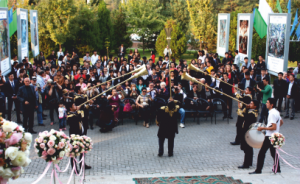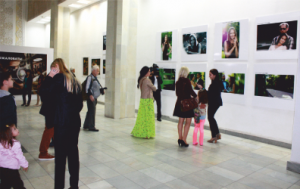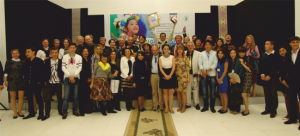Regina Tukhtabaeva,
Art Critic
Open world is a great miracle and opportunity to understand oneself through travelling and recurrence to something different. In opinion of Merab Mamardashwili,… a soul that came back from a journey either will see everything in a different perspective, or it will discover an inner voice in a human being, which a human being should use as a guide, facing the world alone, listening to that inner voice, following it, heeding to the inner vision and voice without influence of any external guidance and authority.
 The VII Tashkent International Photo Biennale 2014 was held in Tashkent from 6 to 12 October of 2014. It is one of the significant events in the world of photography that attracts thousands of visitors to its exposition. The leading masters of photographic art from 32 countries of the world, such as Uzbekistan, Russia, Turkmenistan, United Kingdom, France, Italy, Spain, Brazil, USA, Ukraine, Canada, Azerbaijan, Kazakhstan, Belarus, Moldova, Latvia, Saudi Arabia, etc. have participated in the Photo Biennale.
The VII Tashkent International Photo Biennale 2014 was held in Tashkent from 6 to 12 October of 2014. It is one of the significant events in the world of photography that attracts thousands of visitors to its exposition. The leading masters of photographic art from 32 countries of the world, such as Uzbekistan, Russia, Turkmenistan, United Kingdom, France, Italy, Spain, Brazil, USA, Ukraine, Canada, Azerbaijan, Kazakhstan, Belarus, Moldova, Latvia, Saudi Arabia, etc. have participated in the Photo Biennale.
The organizers of the Photo Biennale 2014 should be particularly mentioned. It is obvious that a huge volume of work had been done at the stage of preparation and in the process of this major festival of photographic art. According to tradition, yet another Photo Biennale was held in several exhibition halls, including the Tashkent House of Photography, the Central Exhibition Hall, the Palace of Youth Creativity, the National Gallery of the Graphic Art of Uzbekistan, the Ikuo Hirayama Cultural Caravanserai and others.
The VII Tashkent International Photo Biennale is primarily aimed at promotion and dissemination of photographic culture in the world, including Uzbekistan. Principal objective of the exhibition is exchange of knowledge and professional experience among the photographers from the different countries, assistance to the young artistic photographers.
The subject of the Photo Biennale of this year was “Parallels. Illusion and Reality”. It is a highly relevant subject at all times. For participants of this event this event was an opportunity to demonstrate their creative ideas and implement them in the framework of the exhibition.
Majority of people live in illusion – with distorted sense of reality, when one attributes to the occurrences the inexistent qualities, features, meaning, etc. Illusions are the fruits of human imagination and thinking, and since the human imagination does not have limits, it is able to upscale the illusions to such extent where a human being perceives them as a reality.
At a first glance to a photograph everything seems clear, however, at times, some intrinsic meaning, an essence of the image are still elusive. Indeed, the photographic picture holds in itself an entire system of information codes and cultural symbols; only by grasping them it is possible to see the substance and not a superficial image. Thus, the Spanish photographer Antonio Mora has presented a series of surrealistic collages entitled “Dream Portraits”, using which the photographer defies the stereotypes of traditional photography. An experienced professional of computer graphics and an outstanding graphical master, Antonio Mora creates wonderful pieces of art using computer for processing of the actual photographic pictures and portraits, where the human faces fantastically transform into the landscape images. The borders of the themes are blended – mountain gorges, waterfall currents and urban scenes become a continuation of human emotions. The resulting collages impress: the elements are selected so carefully that a viewer almost does not distinguish the borders of different images. It is clear that these creations are the products of imagination, however they are strongly convincing, because the artist has accurately studied the world around.
 Antonio Mora is an excellent master of printing on wood, which is quite unusual for this type of art. His creations are enchanting and mystical portraits that are beautiful and mysterious in their own way. Antonio Mora does not dim the intensity of colors in order to highlight his somber, mysterious images. He generously uses contrasting vivid shades to emphasize shadows and dark areas that prove his exuberant imagination and fertile fancy.
Antonio Mora is an excellent master of printing on wood, which is quite unusual for this type of art. His creations are enchanting and mystical portraits that are beautiful and mysterious in their own way. Antonio Mora does not dim the intensity of colors in order to highlight his somber, mysterious images. He generously uses contrasting vivid shades to emphasize shadows and dark areas that prove his exuberant imagination and fertile fancy.
Separate exposition at Photo Biennale is dedicated to the genre of photoanimalism. Today many photographers reckon themselves as photoanimalists, however there are few masters of this genre. Several years ago the British photographer Tim Flach has joined this art. The last ten years of his creative work show that in his art Tim Flach prefers to photograph various animals, while his pictures have a distinctive style. A part of these photographs have been displayed at the Photo Biennale. Each picture has its unique features in terms of composition. The most difficult part in photographing animals, in other words, photoanimalism, is not the process of photo shooting itself, but working with the object, i.e. animals. It is important to monitor the constant changes. Therefore, the photographer’s objective is to catch that moment, which ideally reflects the idea of photographic picture. Surely, the mode of chronophotography helps it, yet one should get focused on animal’s movement and foresee them to take a perfect picture. Tim Flach possesses these qualities. In contrary to other representatives of this genre, Flach photographs the animals in studio using professional lights. An example of this is the series of the portraits of the tigers, dogs and monkeys of various species, pandas and other animals, where every creature is somewhat posing in front of the photographer, who reveals the character of his “personages”. Shooting animals, Flach shows great consideration both to them and to the nature. Such work requires ability to get to the right side of the “difficult” dog, monkey or tiger. With genuine interest Flach studies jelly-fish, bats and owls. Photographs of the artist are unconventional, his style is original, he is in-demand not only in his homeland – UK, but also abroad. His regular customers are such well-known newspapers as “Sunday Times”, “The New York Times”, “The National Geographic” magazine, “Hermes” brand, “Sony” and others. Tim Flach is the Honorary Doctor of the Norwich University of Arts (USA).
 It should be noted that Tim Flach and Antonio Mora are not participants of the contest, they have presented their expositions as special guests. Their works have not only enriched the Photo Biennale’s exhibition, but have also allowed young photographers to get acquainted with creative art of the distinguished artists.
It should be noted that Tim Flach and Antonio Mora are not participants of the contest, they have presented their expositions as special guests. Their works have not only enriched the Photo Biennale’s exhibition, but have also allowed young photographers to get acquainted with creative art of the distinguished artists.
Exposition of the underwater photography has drawn attention of the visitors of this photo exhibition. It is represented by the series of photographs “Dance” of Canadian photographer Gabriela Maj, who has succeeded to make the most attractive and unusual pictures, though the underwater shooting is associated with certain difficulties and requires a special talent.
On many occasions, pictures of the magnificent monuments of architecture and historical heritage of our country have been exhibited at the Photo Biennale, clearly indicating the features and milestones of the historical trace along the development path of global civilization, along which the society, culture and arts are moving from the past towards the future. This is the key attribute of the images of real Uzbekistan, which we can see through the eyes of foreign photographers – Frank Roedel (“Uzbek Diary”) from Germany, and Payram (“Journey to Uzbekistan”) from France.
Famous Japanese photographer – Takeo Akiyama – is the unrivaled master of the common genre art. In the framework of the Photo Biennale he demonstrated his personal photo exhibition dedicated to the city of Tokyo. Takeo Akiyama derived the subjects for his pictures from the everyday life of all layers of the contemporary Japanese society, where he represented people hurrying to the work, Tokyo tram, street procession of dancers in the lion masks, children from Asakusa and other. The series of pictures of the gifted photography artist allows sensing a unique everyday life of Japanese people.
“The Faces of the Central Asia” is the series of the Uzbek photographer, Vladimir Zhirnov, in which he reveals an original culture of the East. The works of the artist are charged with profound symbolic meaning. The talent of the photographer manifests itself in his ability to see, to capture and to convey to the viewers something intangible, yet wonderful and peculiar, what the artist’s eye has seen. The choice of the shooting angle, composition and natural light, the rules of framing, positioning of the focus on the objects of photo shooting are used by the artist in the course of creation of a picture. That is why a piece of art created by the photographer always draws the eye, evokes emotions freely or involuntarily, forces to analyse and contemplate.
The outcomes of the VII Tashkent International Photo Biennale 2014 have been finalized on the 12th October at the official closing ceremony. The winners awarding ceremony has taken place in the Palace of the Youth Creativity, where the best works of the contestants have been exhibited. The judges – Chairman – Masut Fatkulin (Russia), Antonio Mora (Spain), Lyudmila Kodzaeva (Uzbekistan), Thomas Elsen (Germany), Tim Flach (Great Britain), Ive Forester (France) – have declared the winners and awardees of the contest:
The photograph “A girl playing with a ball” of the young photographer from Uzbekistan, Farkhad Karimov, has been awarded the Grand Prix of the VII Tashkent International Photo Biennale;
1st place in nomination “The Best Artistic Photo” – Andrey Vetrov, Belarus;
1st place in nomination “The Best Documentary Photo” shared Zemfira Makhmudova (Azerbaijan) and Olga Korenchuk (Kazakhstan);
Among those, who has presented the best documentary series of photos is Elgar Djafarov (Azerbaijan).
Review of the development of artistic photography within the latest decades allow for making conclusion that the photography manifests itself as a form of art on its own.
Vocation of photographer is to record what is going on in the surrounding environment. The talent of the artistic photographers comes out in their ability to see exactly those things that majority of people pass by every day. Photographer is a person of senses and contemplation, able to visualize a harmony, act as the chronicler of a certain era, which charges them with special responsibility.
The VII Tashkent International Photo Biennale 2014 is the one more contact point for international dialogue. The exhibited works are the vital source of self-cognition and information on the history and culture of various nations. Moreover, similar events contribute to promotion of the art of photography, which enhances a significance of the photo contests, exhibitions and wide-scale events like the Photo Biennale.
